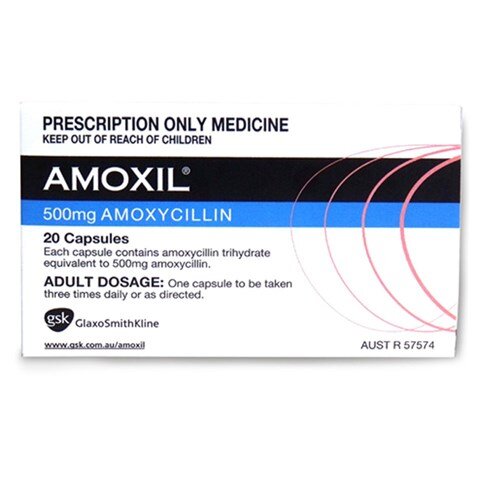Amoxil (Amoxicillin)

Dosages
Amoxil 250 mg
| Quantity | Price per pill | Total price | |
|---|---|---|---|
| 20 | $2.00 | $40.00 | |
| 30 | $1.50 | $45.00 | |
| 60 | $0.92 | $55.00 | |
| 90 | $0.67 | $60.00 | |
| 120 | $0.58 | $70.00 | |
| 180 | $0.56 | $100.00 | |
| 270 | $0.44 | $120.00 | |
| 360 | $0.39 | $140.00 |
Amoxil 500 mg
| Quantity | Price per pill | Total price | |
|---|---|---|---|
| 10 | $4.00 | $40.00 | |
| 20 | $2.25 | $45.00 | |
| 30 | $1.67 | $50.00 | |
| 60 | $1.00 | $60.00 | |
| 90 | $0.72 | $65.00 | |
| 120 | $0.67 | $80.00 | |
| 180 | $0.61 | $110.00 | |
| 240 | $0.50 | $119.00 | |
| 360 | $0.47 | $170.00 |
Payment & Shipping
Your order is securely packed and usually shipped within 24 hours. Below is what a standard package looks like.
Sized like a regular personal letter (9.4×4.3×0.3 inches / 24×11×0.7 cm), with no indication of its contents.



| Shipping Method | Estimated delivery |
|---|---|
| Express Free for orders over $300.00 | Estimated delivery to the U.S.: 4-7 days |
| Standard Free for orders over $200.00 | Estimated delivery to the U.S.: 14-21 days |








Discount Coupons
- Independence Day - Jul 4, 2025 10% JULY410
- Labor Day - Sep 1, 2025 7% LABOR07
- Thanksgiving - Nov 27, 2025 9% THANKS09
Brand Names
| Country | Brand Names |
|---|---|
 Argentina Argentina | Abiotyl Abramox Almorsan Amixen Amox-G Amoxi Amoxibiot Amoxicilina Duo Amoxicina Amoxicler Amoxidal Amoxidal Duo Amoxigrand Amoxipenil Amoxipoten Amoxitenk Amoxol Antiamox Antibiocilina Antiobiocilina Apracur Biotic Ardine Atrival Biotamoxal Bioxilina Clofamox Darzitil Dunox Fabamox Flemoxon Fullcilina Fullcilina Duo Grinsil Grinsil Duo Mixcilin Moxitral Nobactam Optamox Oximar Plamox Telmox Trifamox Trifamox Duo Xalotina |
 Australia Australia | Alphamox Amohexal Ampexin Bgramin Cilamox Fisamox Ibiamox Maxamox Moxacin |
 Belgium Belgium | Amoxi Amoxycaps Amoxypen Bactimed Clamoxyl Docamoxici Flemoxin Hiconcil Moxaline Moxitop Novabritine |
 Brazil Brazil | Amoflux Amox Amoxadene Amoxi-Ped Amoxibron Amoxicap Amoxicom Amoxidil Amoxifar Amoximed Amoxina Amoxipen Amoxitan Amplal Amplamox Ariproxina Bimoxin Camoxin Cibramicina Ductocilina Duzimicin Farmoxil Flemoxon Hiconcil Hincomox Ibamoxil Licilon Lifamox Moxiplus Nemoxil Neo Moxicilin Novacil Novocilin Novoxil Ocylin Penvicilin Pharmox Polibac Polimoxil Probenil Prodoxil Respicilin Trimox Ultramox Uni Amox Velamox |
 Canada Canada | Amox Apo-Amoxi Lin-Amox Novamoxin Nu-Amoxi |
 Czechia Czechia | Amoclen Amogal Amoxihexal Apo-Amoxi Duomox Gonoform Grunamox InfectoMox Ospamox |
 Denmark Denmark | Flemoxin Imacillin Imadrax |
 Finland Finland | Amorion Amoxin Clamox Flemoxin Penalta |
 France France | A-Gram Amodex Amophar Amoxine Bactox Bristamox Clamoxyl Flemoxine Gramidil Hiconcil Zamocilline |
 Germany Germany | Aloxyn Amagesan Amc-Puren Amoxi amoxi-basan Amoxi-Diolan Amoxi-Hefa Amoxi-Puren Amoxi-Tablinen Amoxi-Wolff Amoxibeta Amoxibiocin Amoxidoc Amoxihexal Amoxillat Amoximerck Amoxypen Clamoxyl Cuxacillin Dignoamoxicillin dura AX espa-moxin Flui-Amoxicillin Glassatan InfectoMox Jephoxin Jutamox Padiamox Phamoxi Sigamopen Ulcolind Amoxi Uro-Clamoxyl |
 Greece Greece | Amospes Amoximycin Aproxal Bimoxal Chromoxyl Daminopen Dipenocin Drinus Flemoxin Geymocillina Izoltil Lamberin Matasedrin Ospamox Paradroxil Prevasal Princimox Selevistine Stevencillin Surmagal Triodanin Wesfem |
 Hungary Hungary | Clonamox Duomox Humamoxin Ospamox |
 Italy Italy | Alfamox AM 73 Amocrin Amoflux Amosol Amox Amoxibiotic Amoxillin Amoxina Amoxipen Aspenil Bradimox Cabermox Dodemox Erremox Genimox Helimox Hydramox Ibiamox Isimoxin Majorpen Mopen Moxiren Neo-Ampiplus Neotetranase Oralmox Pamocil Piramox Progemox Sievert Simoxil Simplamox Sintopen Velamox Zamocillin Zimox |
 Japan Japan | Pasetocin |
 Malaysia Malaysia | Beamoxy Moxacil Moxilen Moxipen Ospamox Setmoxil |
 Mexico Mexico | Acimox Acroxil Ameclina Amicil Amobay Amoxifur Amoxinovag Amoxisol Amoxivet Ampliron Amsaxilina AMX Ardine Armoxin Axcil Betabiot Bimoxan Biotaxil Biovicam Brenoxil Deniren Dimopen Doxamil Examolin Flemoxon Gimalxina Grunicina Hidramox Limoxin Lorexil M Lumox Micro Mox Mocimed Moxicel Moxiclina Moxlin Penamox Penticlox Polymox Prodomix Servamox Servamox-F Solciclina Vandix Xalyn-Or Xiprocan |
 Netherlands Netherlands | Amoxi Amoxilag Clamoxyl Flemoxin Hiconcil |
 New Zealand New Zealand | Alpha-Amoxi Apo-Amoxi Flemoxin Ibiamox Moxlin Ospamox Penamox |
 Norway Norway | Amimox Amoxillin Imacillin |
 Poland Poland | Amotaks Apo-Amoxi Duomox Grunamox Hiconcil Novamox Ospamox |
 Portugal Portugal | Amplamox Bodisan Cipamox Clamoxyl Flemoxin Moxadent Moxipen Oraminax Ospamox Penamox |
 Spain Spain | Actimoxi Acuotricina Agerpen Amitron Amoflamisan Amox Amoxaren Amoxibacter Amoxidel Amoxi Gobens Amoximedical Amoxipen Amoxyvinco Apamox Ardine Axibiot Becabil Bimoxi Bioxidona Blenox Bolchipen Borbalan Britamox Brondix Cidanamox Clamoxyl Co Amoxin Combitora Dacala Damoxicil Diacibrone Dobriciclin Edoxil Eupen Flubiotic NF Hortepulmo Antibio Hosboral Inexbron Maxiampil Mediamox Metifarma Morgenxil Moxipin Novagcilina Olmopen Precopen Raudopen Recefril Reloxyl Remisan Riotapen Salvapen Suamoxil Superpeni Teramox Tolodina Wassermox |
 Sweden Sweden | Amimox Amoxiferm Bristamox Flemoxin Imacillin |
 Turkey Turkey | Alfoxil Amoksilav Amoksilin Amoksina Amosin Atoksilin Demoksil Largopen Moksilin Remoxil Topramoxin |
 United States United States | Biomox DisperMox Larotid Moxatag Polymox Trimox Wymox |
| Manufacturer | Brand Names |
|---|---|
| Sun Pharmaceutical Industries Ltd. | amx Svizmox |
| Svizera Labs Private Limited | amx Svizmox |
FAQ
Description
Amoxil, the brand name for amoxicillin, is a widely used antibiotic belonging to the penicillin group. It is primarily prescribed to treat bacterial infections such as respiratory tract infections, ear infections, skin infections, and urinary tract infections. Amoxil works by inhibiting the growth of bacteria, making it effective in treating a range of infections caused by susceptible bacteria.

Clinical Pharmacology
Amoxil contains amoxicillin, a beta-lactam antibiotic that interferes with bacterial cell wall synthesis. By binding to penicillin-binding proteins (PBPs), amoxicillin disrupts the formation of the bacterial cell wall, ultimately leading to the destruction of the bacteria. It is bactericidal against many Gram-positive and Gram-negative microorganisms, including Streptococcus pneumoniae, Haemophilus influenzae, and Escherichia coli. The absorption of Amoxil is rapid, with peak plasma concentrations occurring one to two hours after oral administration.
Ingredients
The active ingredient in Amoxil is amoxicillin. The formulation also includes several inactive ingredients, such as magnesium stearate, colloidal silicon dioxide, microcrystalline cellulose, and colorants, depending on the form (capsule, tablet, or suspension).
What Are the Dosages of Amoxil?
| Form | Strengths Available | Typical Dosage for Adults | Typical Dosage for Children |
|---|---|---|---|
| Capsules | 250 mg, 500 mg | 250-500 mg every 8 hours | 20-40 mg/kg/day in divided doses |
| Tablets | 500 mg, 875 mg | 500-875 mg every 12 hours | 20-40 mg/kg/day in divided doses |
| Oral Suspension | 125 mg/5 mL, 250 mg/5 mL | Dose depends on body weight and type of infection | 20-40 mg/kg/day in divided doses |
The exact dosage of Amoxil may vary depending on the severity of the infection, the patient's age, weight, and renal function. Always follow the healthcare provider's instructions.
Important Safety Information
Do not take Amoxil if you are allergic to amoxicillin, penicillin, or any other beta-lactam antibiotics.
Inform your doctor if you have a history of liver disease, kidney disease, asthma, bleeding disorders, or mononucleosis.
Amoxil is categorized as a Pregnancy Category B medication by the FDA. This means that animal studies have not demonstrated any risk to the fetus. Still, there are no well-controlled studies in pregnant women. Amoxil is generally considered safe for use during pregnancy when clearly needed and prescribed by a healthcare provider. However, it should only be used when the potential benefits outweigh the risks. Pregnant women should always consult their doctor before starting any medication, including Amoxil.
Amoxicillin is excreted in breast milk in small amounts. While Amoxil is generally considered safe for use during breastfeeding, there is a possibility of side effects in the nursing infant, such as diarrhea, rash, or allergic reactions. Nursing mothers should use Amoxil only under the guidance of a healthcare provider and report any unusual symptoms in their infant to a doctor immediately.
Amoxil is frequently prescribed for children to treat various bacterial infections, including ear infections (otitis media), throat infections (tonsillitis), and respiratory tract infections. The dosage for children is based on body weight and the type and severity of the infection. Pediatric use is generally safe when following the prescribed dosage and duration. However, children may be more susceptible to side effects such as diarrhea, rash, and allergic reactions.
Older adults may be more prone to specific side effects of Amoxil, particularly those related to kidney function, as renal impairment is more common in this age group. Dosage adjustments may be necessary for elderly patients with decreased renal function to prevent drug accumulation in the body. Monitoring for potential interactions with other medications is also essential, as older adults are more likely to take multiple medications.
In all special populations, it is essential to use Amoxil under the supervision of a healthcare provider to ensure safety and efficacy.
Prescription
Amoxil is a prescription medication and should be used only under the guidance of a healthcare provider. It is crucial to complete the full course of the antibiotic, even if symptoms improve, to prevent the development of antibiotic-resistant bacteria.
Contraindications
Amoxil is contraindicated in individuals with:
- a history of hypersensitivity to amoxicillin or any other penicillin or beta-lactam antibiotic;
- a history of severe allergic reactions, such as anaphylaxis or Stevens-Johnson syndrome, to any antibiotic.
Side Effects
Common side effects of Amoxil may include:
- nausea, vomiting, or diarrhea;
- skin rash or itching;
- headache;
- dizziness.
Serious side effects are rare but may include severe allergic reactions, liver dysfunction, and blood disorders. Contact your healthcare provider if you experience any severe or unusual symptoms.
Interactions of Amoxil with Other Medicines
Amoxil can interact with other medications, affecting how it works or increasing the risk of side effects. Some notable interactions include:
- Methotrexate: Increased toxicity of methotrexate.
- Oral Contraceptives: Reduced efficacy of birth control pills.
- Probenecid: Increased concentration of amoxicillin.
- Anticoagulants: Increased risk of bleeding when used with anticoagulants like warfarin.
Always inform your doctor about all your medications, including over-the-counter drugs and supplements.
Overdose of Amoxil
An overdose of Amoxil may cause symptoms such as severe nausea, vomiting, diarrhea, or a rash. In cases of suspected overdose, seek immediate medical attention. Overdose management may involve symptomatic treatment and supportive care, including hydration and renal function monitoring.
Storage
Amoxil should be stored at room temperature, away from moisture and heat. The oral suspension should be refrigerated and discarded after 14 days. Keep all medications out of the reach of children.
Benefits of Amoxil
Amoxil is a versatile antibiotic that is effective against a wide range of bacterial infections. It is well-tolerated by most patients and is available in various forms, making it suitable for people of all ages. It can be used for both acute and chronic infections and is often a first-line treatment due to its proven efficacy and safety profile.






